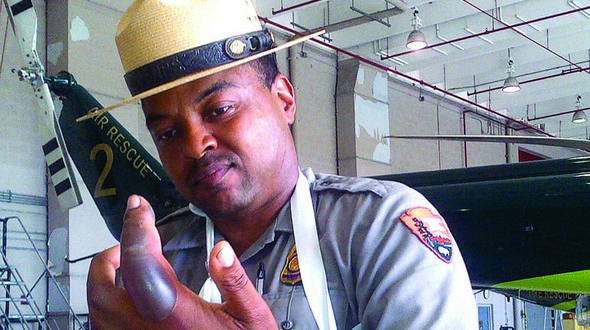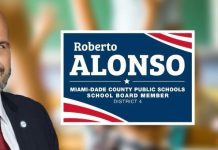

Gonzalez, MDFR Air Rescue pilot, are pictured on their way to rescue Park Ranger Anthony (Tony) Terry in
Everglades National Park.
Lt. Scott Mullin immediately jumped to action after receiving the call that Park Ranger Anthony (Tony) Terry had been bitten by an Eastern Diamondback Rattlesnake. Terry was bitten on his left hand while attempting to remove the rattlesnake from his home located in Everglades National Park.
Mullin is with the Miami-Dade Fire Rescue Department’s (MDFR) Venom Response Team. Terry was about 130 miles into the park, so the fastest way to him was by helicopter.
Mullin coordinated Terry’s transport via MDFR Air Rescue to Baptist Health’s Homestead Hospital. He traveled with Air Rescue, carrying the antivenin , to Everglades National Park and then on to the hospital where he oversaw the administration of the first dose of antivenin within one hour of the 9-1-1 call. A total of 28 vials of antivenin were used to reverse the effects of the toxin.
“Our Venom Response Team almost got cut during the last budget hearings,” Mullin said. “Tony could have died or lost his arm if we hadn’t been able to immediately respond to the call on a Saturday (Sept. 28),” Mullin said. “It is important for the public to know that our Venom Response Team is here to protect our community, frequently saving people’s lives and educating people in South Florida.”
According to Mullin, most snakebites in South Florida happen on the weekends when people are out and about enjoying the great outdoors. The Eastern Diamondback Rattlesnake is native to South Florida and other areas in the United States and has the reputation of being the most dangerous venomous snake in North America. A dose of 100 mgs of its venom is lethal to humans within two hours. A single bite can inject up to 800 mgs of venom, which causes tissue death and disables the body’s ability to clot causing the person to bleed to death.
Park Ranger Terry was treated in the ICU at Homestead Hospital and was expected to make a full recovery.
The MDFR Venom Response Program specializes in the response, management, and treatment of envenomations. The program provides ongoing education, training and awareness of the many dangerous and venomous species native to, or imported into the United States and promotes interoperability and communication between numerous agencies, municipalities, healthcare providers and poison control centers.
The Venom Response Team currently maintains the largest and only antivenom bank for public use in the United States. The team employs the latest techniques to prevent death through antivenin intervention 24 hours a day, seven days a week, locally, nationally, and internationally.






